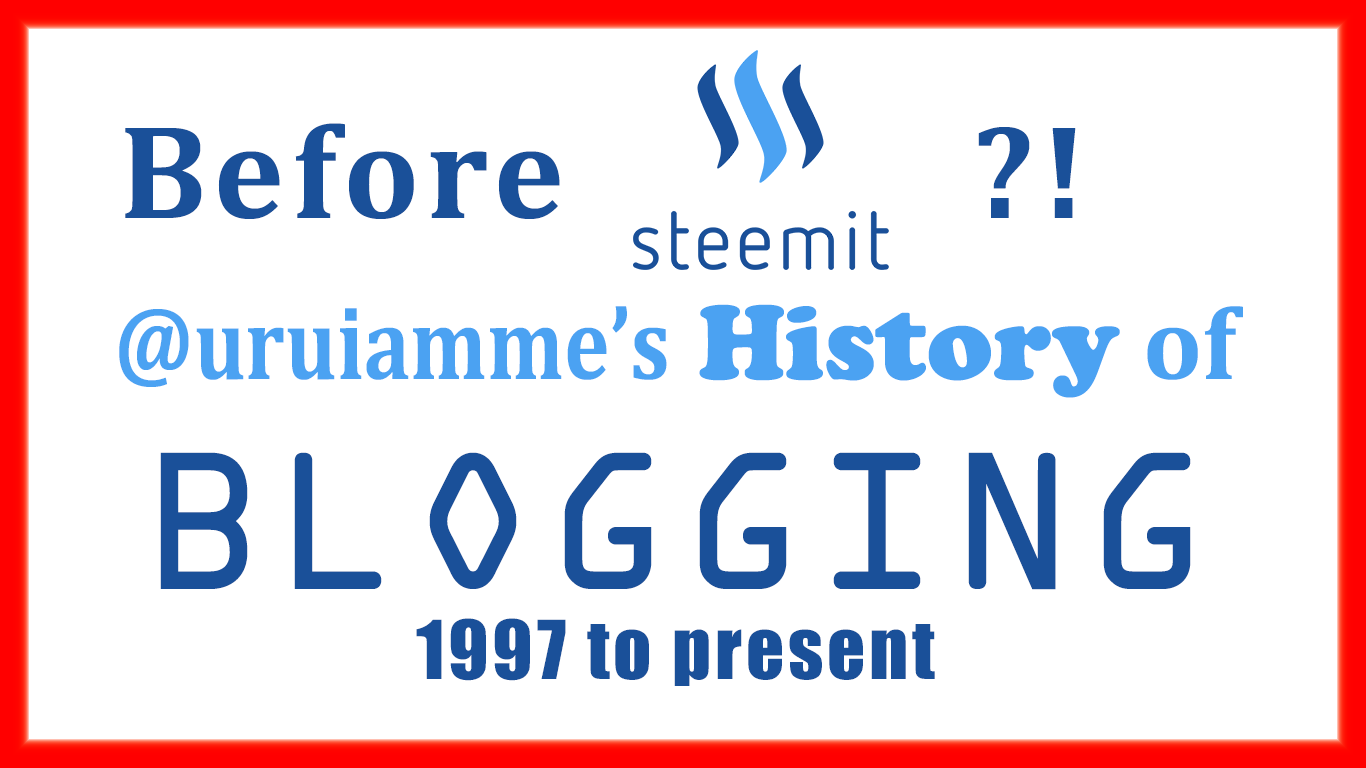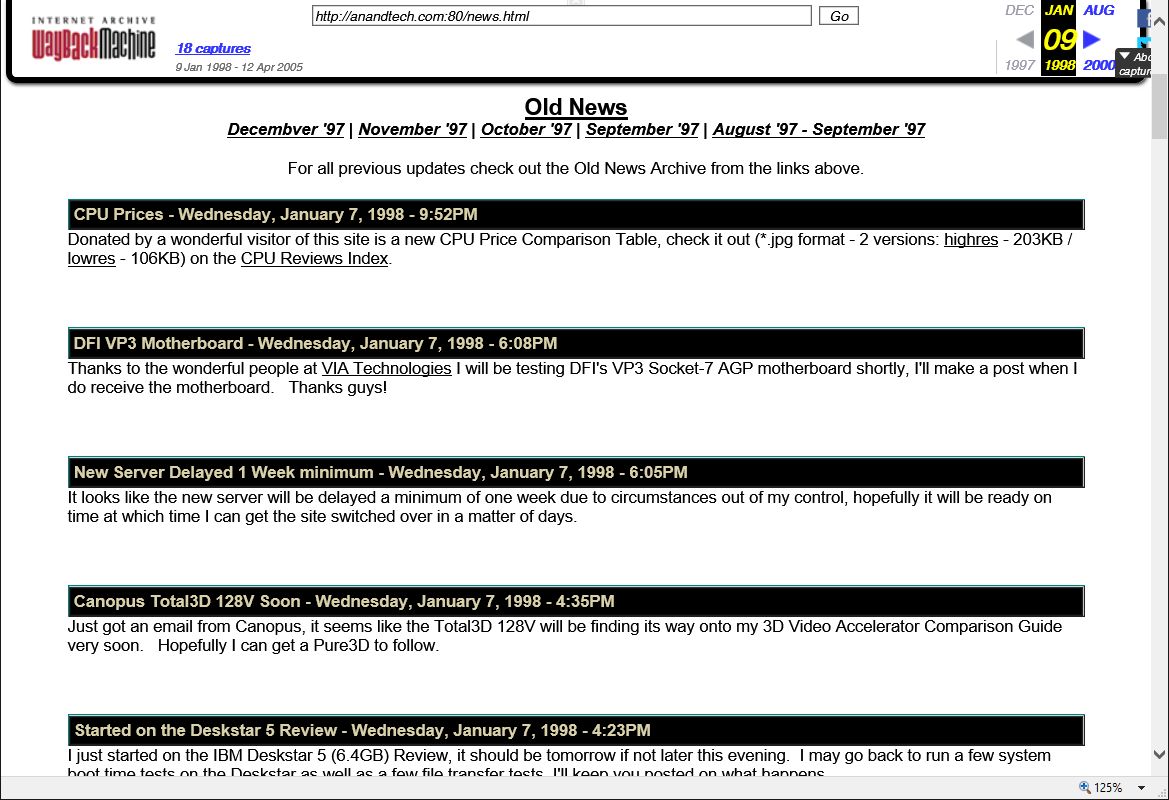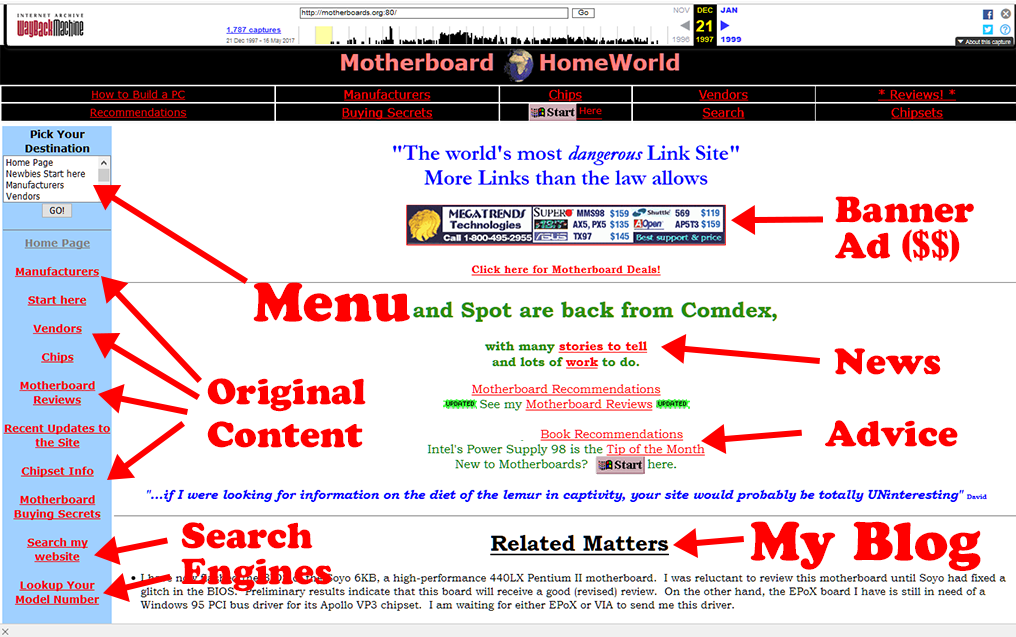Part 5 of the @uruiamme Introduction:
Blogging before there was such a word, 20 years ago in 1997

I have now flashed the BIOS of the Soyo 6KB, a high-performance 440LX Pentium II motherboard. I was reluctant to review this motherboard until Soyo had fixed a glitch in the BIOS. [...]
Fall Comdex is over now, and Spot and I have got ten times the work load that we started with. We will be updating the site extensively with new product information and motherboard reviews. As you might guess, our e-mail boxes were full, and since Spot is such a slow typer, I'll be answering them when I can. [...]
11/9/97: There is a new Pentium Bug reported by "noname@noname.com" using a dial-up account at the University of Texas. Visit either the Linux Advocacy newsgroup or the Intel System newsgroup and look for the long thread. Original Subject was: This code will lock up any P5 machine, even usermode Linux! (F0 0F C7 C8), original post was made on Thursday the 6th. However, Robert Collins says he's known of this bug for awhile, and so apparently has Intel, but since the bug applies [...]
10/30/97: I have just received three motherboards from EPoX and Soyo. I'll be reviewing them soon. Yee Haw! There are two AGP boards in the bunch, so get ready for something different.
See what's in store for the old power supply
AGP is finally here, sort of. The VIA Apollo VP3 chipset has been released [...] when my 64 MB SDRAM DIMM arrives, the review will be soon to follow.
...And the winner is... Someone has just released an AGP board for Socket 7. It's 4:30 am on October 9, and I have confirmation that the VIA VP3 has finally made it to shipping motherboards. Please see my Manufacturers page for more details.
How did I start blogging in 1997?
Sometime in early to mid 1997, I became aware of a handful of other websites that were becoming popular. There were 2 or 3 that were more popular than mine which stick out in my mind. The three most influential: Tom, Anand, and Robert Collins. Dr. Thomas Pabst had the wildly popular Tom's Hardware Site. Anand Shimpi, a minor at the time, started the AnandTech website after a stint on GeoCities. And Robert Collins was the owner of Intel Secrets (x86.org), known for his pioneering study of Intel processor opcodes... and the 1996 Intel lawsuit against him, Intel v. Robert Collins.All four of us pioneers have walked away from blogging, computer reviews, and maintaining a website.
Proof of entrepreneurs who left:
Me. @uruiamme. I am writing this Introduction. I sold my website and domain in mid-1999 to an investor.
Anand. In 2014, he went to Apple computer after selling his site.
Dr. Thomas Pabst. "In 2006, he sold the site walked away" after selling out.
Robert Collins. The link above to his resume indicates that he went to Dr. Dobb's Journal to do some writing, but continued to work in the hardware industry until at least 2005.
All of our 1997 domains are still active or owned by a corporate entity.
As far as I know, I had probably seen Anand's 1997 blog, which he called "News." Here is a screenshot from Anand's News.

Actual blog from early 1998. This is the prototypical blog from the 1990s... it had the date and time, and it was written in reverse order, the most recent "news" on top. Anand, then still a minor, was one of the first.
I didn't exactly copy this format, but I was influenced by early bloggers and had my own section on the home page. If you've been following my introduction, this will look familiar:

I didn't always date my blog. Anand was "blogging" a few times a day, whereas I wanted to go a week or more between edits.
In 2007, when I realized that I had been a blogger in the early days of the web, I wrote this:
For my own site, I believe that I started blogging around June of 1997, with a possible earlier date of March 1997.
I was not the first blogger. But while I cannot exactly credit the original idea to Anand, what I can say is that web logs were definitely in existence in 1997, and commonly so, in my industry. We were pioneering a concept that has now become ubiquitous, and served as a geek-style prototype to Blogger, Wordpress, and now STEEM and steemit.com.
According to retrospectives on blogging, the term web log was coined on December 17, 1997, and the term blog was coined in April or May 1999. (Sources: 1 and 2 and 3.) I blogged about 6 to 9 months before even the earlier date, and before SlashDot, LiveJournal, or Blogger were started.
Modern Blogging: Why blog?
For at least two decades, web logs have served to disseminate an expert's opinion and insider gossip to interested readers. It is like a modern form of standing around at the gate of a city to see what's new and to hear the events of the day. The major aspect of blogging (and later tweeting or snapchatting) is that anyone with an insight into something, perhaps a niche, can write a blog.- What are you an expert in? Write about it.
- What secret or unknown facts do you know about? Write about them.
- Have you heard rumors about something new and different? Put them into digital form for others to view.
- Do you have an interest or set of experiences that other people relate to? Become the authority on the subject and blog about it.
- Can you put together a montage of information on a subject and curate it for others? Collect this information and redistribute it with commentary.
- Are you interested in opinions and ideas? Read blogs, comment, and follow!
- BLOG LIKE THIS ON STEEM IN 2017, OWN THE RIGHTS TO YOUR CONTENT YOURSELF, AND MAKE CRYPTO (and fiat) MONEY!
On an early 1997 website, blogging was part of the appeal to visitors... to get them interested in the content of the website. We made money on ads, as you know from Part 4.
Why STEEM?
In contrast to the 1990s, STEEM blogging pays people directly. No advertising involved. No hand-coding HTML involved (see part 2).You make money blogging on STEEM by having good content and a good set of followers. Would you be mine? ❤️
Now it's your turn
Follow me, follow me!! @uruiamme is my name. After my introduction, I will be moving on to other juicy topics. (I already have started!!)Part 1: My Introduction and the value of content on the web
Part 2: The development and success of the Motherboard HomeWorld, 1996 to 1999
Part 3: Search Engines before the dot-com bust
Part 4: Web Advertising before the dot-com bust
Part 5: [You are here] Blogging before the term existed
This concludes my long Introduction on Steemit as a former website owner, blogger, content creator, entrepreneur, and web pioneer. I have been having fun so far. I have a lot more things to come!
